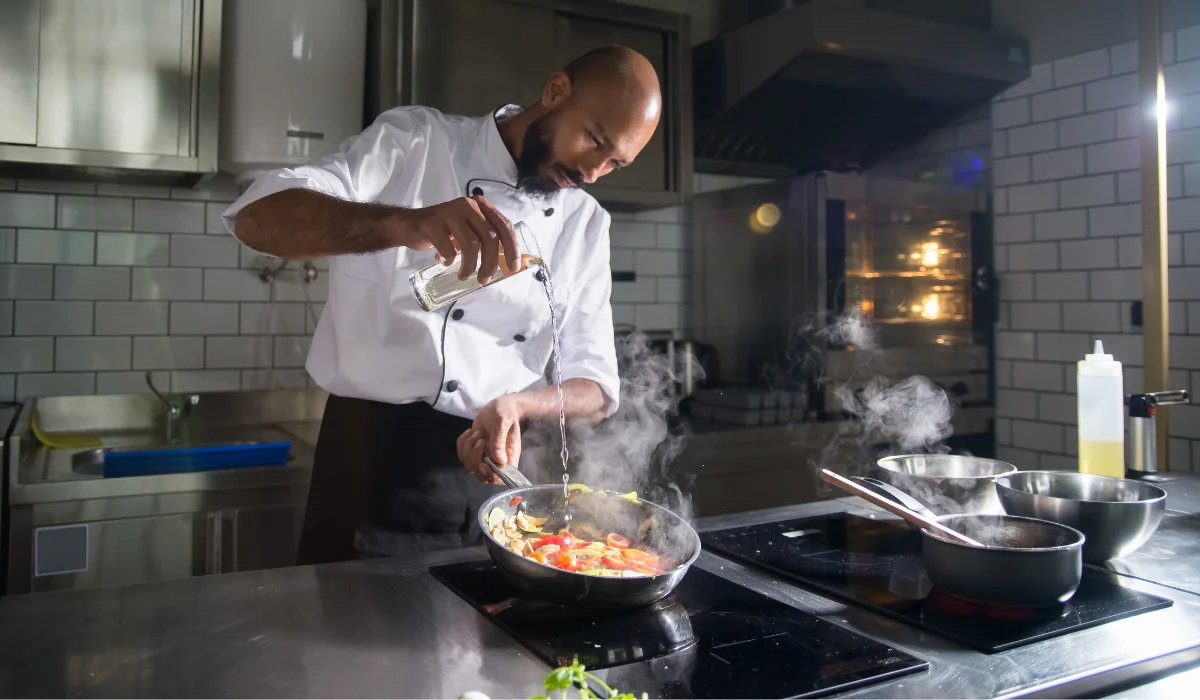Cooking in a commercial kitchen is a whole different ball game compared to cooking in a standard private home kitchen. The challenges, opportunities, and considerations that come with operating in a commercial kitchen are vast and can significantly impact the success and efficiency of a food business. In this article, we will explore the key differences between cooking in these two environments and why commercial kitchens are essential for professional chefs and restaurateurs.
Design and Flow
One of the most significant distinctions between a commercial kitchen and a home kitchen is the emphasis on design and flow. In a restaurant setting, every inch and second matters. Chefs and cooks need to move swiftly and seamlessly to ensure smooth operations and timely service. This is why careful planning and consideration of kitchen layout are crucial.
In a home kitchen, the focus may be on aesthetics and personal preferences, but in a commercial kitchen, functionality, and efficiency take precedence. The flow of the kitchen must be optimized to ensure that tasks are performed smoothly, from food preparation to plating and serving. Commercial kitchen designers spend time measuring and planning the placement of workstations, sinks, dishwashing areas, and storage spaces to create a well-organized and efficient workspace.
See Also: How to Launch a Successful Ghost Kitchen Business?
Sinks and Sanitation
Commercial kitchens require a higher level of sanitation and cleanliness due to the larger scale of food production and service. The presence of multiple sinks is a standard feature in a commercial kitchen, each serving a specific purpose. A good prep sink with a solid work surface is essential for messy tasks such as butchering and vegetable preparation. Handwashing sinks are strategically placed to ensure easy access for kitchen and service staff.
The presence of multiple sinks helps maintain a clean and hygienic environment, reducing the risk of cross-contamination and ensuring proper sanitation practices. Additionally, commercial kitchens often have dedicated dishwashing areas with industrial-grade dish machines, making it easier to handle large volumes of dishes efficiently.
Ventilation and Hood Systems
Commercial kitchens deal with higher heat and cooking fumes generated by multiple appliances and cooking stations operating simultaneously. Proper ventilation and hood systems are crucial to maintaining a comfortable and safe environment for kitchen staff.
In a standard home kitchen, ventilation may not be a primary concern, but in a commercial kitchen, it is a top priority. Hood systems are designed to capture and remove heat, smoke, grease, and odors, ensuring that the air remains clean and breathable. Adequate ventilation also prevents the buildup of excessive heat, making the kitchen more comfortable for chefs and cooks to work in.
Cooking Equipment and Storage
Commercial kitchens require specialized cooking equipment to handle the demands of high-volume production. Chefs often opt for new or top-quality cooking equipment to ensure reliability and durability. While used cooking equipment may be suitable for some cases, refrigeration units are generally recommended to be purchased new to avoid potential issues.
The availability of essential cooking equipment such as combination units with ovens, flat-top griddles, and burners can significantly impact the efficiency of the kitchen. Additionally, commercial kitchens typically have dedicated walk-in coolers and freezers to store large quantities of ingredients and prepped items, further differentiating them from standard home kitchens.
Also Read: Maximizing Profits with White-Label Food Delivery Solutions
Work Tables and Preparation Space
In a commercial kitchen, mise en place and preparation are key components of a smooth and efficient operation. Work tables are strategically placed between cooking units to allow for easy access to tools and ingredients, reducing the need for cooks to turn around constantly. This setup streamlines the cooking process and ensures that every step counts, saving valuable time and effort.
In a home kitchen, work tables and preparation space may not be given as much emphasis since the scale of cooking is typically smaller and less demanding.
Professionalism and Creativity
Finally, a commercial kitchen is a space where professionalism and creativity collide. Chefs and cooks in a commercial kitchens are continuously looking for ways to improve, streamline, and evolve their culinary creations. The professional setting encourages collaboration, learning, and growth, fostering a culture of excellence and innovation.
In a standard home kitchen, the focus may be on comfort and enjoyment, but in a commercial kitchen, it’s about delivering exceptional dishes to customers while adhering to strict food safety and quality standards.
Storage Solutions
In a commercial kitchen, efficient storage solutions are a game-changer. With the high volume of ingredients and supplies needed to run a restaurant, proper storage is essential to maintaining organization and minimizing waste. Commercial kitchens are equipped with ample shelving, walk-in coolers, freezers, and pantry spaces to accommodate large quantities of perishable and non-perishable items.
Walk-in coolers and freezers are a chef’s best friend in a commercial kitchen. These spacious units provide an ideal environment for storing fresh produce, meat, dairy, and other temperature-sensitive ingredients. The ability to buy ingredients in bulk and store them properly helps chefs save money and reduces the frequency of trips to suppliers.
In addition to walk-ins, commercial kitchens often have designated dry storage areas for non-perishable items like canned goods, grains, and spices. Properly organized storage spaces make it easier for kitchen staff to locate ingredients quickly, improving overall efficiency during food preparation.
See Also: 10 Food Tech Trends and Innovations
Staffing and Teamwork
In a home kitchen, one person usually takes on the role of chef, handling all cooking tasks and responsibilities. However, a commercial kitchen is a hive of activity with a team of skilled professionals working together to deliver exceptional meals to customers. The division of labor and coordination among kitchen staff are essential for a smooth operation.
A typical commercial kitchen team consists of line cooks, sous chefs, pastry chefs, prep cooks, and dishwashers, each with specific roles and responsibilities. The ability to work collaboratively as a team is crucial in a fast-paced environment where timing and synchronization are critical. Effective communication and mutual respect among team members ensure that dishes are prepared accurately and delivered promptly.
Time Management
In a standard home kitchen, there is often more flexibility in cooking timeframes. A home cook can take their time experimenting with flavors and techniques, but in a commercial kitchen, time management is paramount. Restaurants have a schedule to uphold, and customers expect their meals to be served promptly.
Commercial kitchen chefs and cooks must be skilled at multitasking and handling multiple orders simultaneously. They need to gauge cooking times accurately, manage various cooking stations efficiently, and ensure that dishes are plated and served at the right moment. Time management skills are honed through experience and practice, allowing chefs to maintain high-quality standards even during the busiest hours.
Related: How to Develop a Food Delivery App like Deliveroo?
Volume and Consistency
The volume of food produced in a commercial kitchen dwarfs that of a home kitchen. From breakfast to dinner service, restaurants churn out hundreds of meals daily, and each dish must meet the same high standards of taste and presentation. This level of consistency requires precision, skill, and attention to detail.
In a home kitchen, a minor variation in taste or appearance may be acceptable, but in a commercial setting, consistency is non-negotiable. Customers expect the same level of excellence every time they dine at a restaurant. Achieving this level of consistency demands rigorous recipe testing, standardized cooking techniques, and a commitment to delivering excellence with every plate.
Managing Food Waste
Minimizing food waste is a challenge that both home and commercial kitchens face, but in a professional setting, the stakes are higher. Commercial kitchens deal with larger quantities of ingredients, and waste can have a significant impact on costs and sustainability.
To combat food waste, chefs and restaurant managers implement various strategies, such as careful inventory management, portion control, and creatively using surplus ingredients. Additionally, many restaurants are adopting sustainable practices, such as composting and donating excess food to local charities, to reduce their environmental footprint.
See Also: Best Sites like Groupon to Get Discount Vouchers
Creativity within Constraints
Cooking in a commercial kitchen often involves working within constraints, such as limited time, space, and ingredients. Chefs must be adaptable and resourceful to create diverse and exciting menus while staying within the restaurant’s parameters.
Commercial kitchens may also face dietary restrictions, allergies, and special requests from customers, requiring chefs to tailor dishes without compromising on taste and quality. Creativity thrives in such environments, where chefs learn to innovate and come up with new culinary delights while adhering to the restaurant’s overall concept and brand identity.
Health and Safety Standards
While food safety is important in all kitchens, commercial kitchens must adhere to stricter health and safety standards due to the higher volume of food preparation. Restaurants are subject to regular inspections to ensure compliance with food safety regulations.
Chefs and kitchen staff are required to undergo food safety training, which covers proper food handling, sanitation, and storage practices. The risk of foodborne illnesses and contamination is more significant in a commercial setting, implementing these standards critical to protecting the health of customers and maintaining the restaurant’s reputation.
Also Read: How Do I Know If I Need Pest Control?
Conclusion
Cooking in a commercial kitchen is an exhilarating journey filled with challenges, creativity, and the pursuit of excellence. From meticulous kitchen design and efficient flow to the importance of teamwork and time management, every aspect of a commercial kitchen contributes to its success. Those who lease or rent a kitchen for business purposes have different expectations and goals than the typical home cook.
Professional chefs and restaurateurs thrive in this dynamic environment, continuously evolving and adapting their culinary skills to meet the demands of their customers. The art of cooking in a commercial kitchen goes beyond the mastery of recipes; it requires a passion for innovation, a dedication to quality, and a commitment to providing unforgettable dining experiences.
As the heart of a restaurant, the commercial kitchen is where the magic happens—where ingredients transform into culinary masterpieces that delight the senses and leave a lasting impression on diners. With proper planning, a focus on efficiency, and a passion for culinary artistry, cooking in a commercial kitchen becomes a rewarding and fulfilling endeavor for chefs and customers alike. Whether it’s a bustling restaurant, a trendy cafe, or a gourmet bakery, the essence of the culinary experience lies in the heart of the commercial kitchen.





















